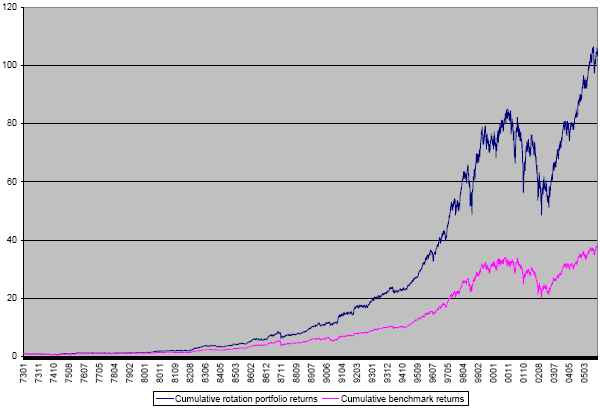Is there a key indicator that investors can use as a signal to overweight stocks of cyclical (non-cyclical) industry sectors that should outperform during economic expansions (contractions)? In their July 2007 paper entitled “Sector Rotation and Monetary Conditions”, flagged by a reader, Mitchell Conover, Gerald Jensen, Robert Johnson and Jeffrey Mercer evaluate a sector rotation strategy that emphasizes cyclical (defensive) stocks when the Federal Reserve shifts to easing (tightening) the discount rate. Using daily returns for a value-weighted U.S. equity market index, four noncyclical sectors (Resources, Noncyclical Consumer Goods, Noncyclical Services, Utilities) and six cyclical sectors (Cyclical Consumer Goods, Cyclical Services, General Industrials, Information Technology, Financials, and Basic Industries) during 1973-2005, they find that:
- There are 14 discount rate policy shifts over the sample period, an average of one every 2.36 years. Monetary policy is expansive (restrictive) about 57% (43%) of the time, and the average total change in the discount rate during a policy period is 3.3%.
- Every sector has higher average returns when monetary policy is expansive (the discount rate is falling). The difference in average returns between expansive and restrictive policy periods is a very large 18.0% for the cyclical sectors but just 4.4% for the noncyclical sectors.
- The average standard deviation of returns is higher during restrictive policy periods for both noncyclical and cyclical sectors.
- A sector rotation portfolio that equally weights the six cyclical (four noncyclical) sectors
during periods of expansive (restrictive) monetary policy significantly outperforms a market portfolio by an average 3.78% per year before transaction costs. It outperforms a benchmark portfolio that equally weights all ten sectors by an average 3.49% per year before transaction costs. Since monetary policy changes infrequently, transaction costs should be small compared to these figures. - Rotation strategy outperformance accrues mostly when stocks are weak. Specifically, the strategy beats the market and the equally-weighted sector benchmark by 4.9% and 5.3% (2.3% and 2.8%), respectively, during restrictive (expansive) monetary policy periods.
- Rotation strategy outperformance during the first and second halves of the sample
period is comparable. Its effectiveness has not diminished over time.
The following chart, taken from the paper, compares the cumulative values of one dollar investments in the the sector rotation strategy portfolio and a benchmark portfolio that weights all sectors equally throughout the 1973-2005 sample period. Rotation strategy outperformance is fairly consistent, suggesting that investors have not exploited monetary policy return patterns.

In summary, investors can significantly outperform the broad U.S. stock market by rotating into cyclical (noncyclical) sectors when the Federal Reserve discount rate begins falling (rising).